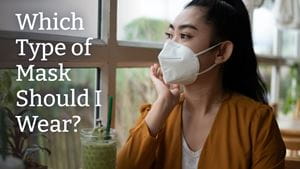
One of the most common recommendations from public health officials about lessening the risk of spreading or becoming sick with COVID-19 is to properly wear a mask or face covering.
As the pandemic continues and more research becomes available, some masks are shown to be more effective at protecting individuals against COVID-19.
Jennifer Gutowski, the Associate Director of Infection Prevention for Rochester Regional Health, explains each type of mask and how effective it is at protecting you from becoming sickened by COVID-19 and other viruses.
The COVID-19 virus spreads primarily through respiratory droplets that are inhaled when people breathe, talk, sneeze, cough, or sing – according to the CDC. Because COVID can be spread even when a person doesn’t have symptoms, consistent masking in the community is important to stop the spread of COVID.
Multiple studies conducted in a variety of settings show the benefits of wearing a well-fitted, multi-layered mask when it comes to preventing both the release and inhalation of those respiratory droplets. The layers trap the particles and droplets and keep them from spreading the virus to others.
For people who may be exhaling infectious droplets, a well-fitted mask can block 50-70 percent of the particles and droplets being emitted. For people who are wearing a well-fitted mask as a way to protect themselves from contracting COVID-19, mask wearing adds another layer of protection against inhaling droplets from an infected individual.
A well-fitted mask should:
“Masks are a small but effective tool in limiting the spread of COVID-19 and other viruses that spread via aerosol particles,” Gutowski said. “Different types of masks offer different levels of protection.”
Since the beginning of the pandemic, several varieties of masks have been made available to the public to wear as a way to protect the health and safety of both individuals and the community as a whole.
Often featuring a variety of patterns and colors, cloth masks can be made of a variety of different fabrics.
A well-made cloth mask offers protection through multiple layers of tightly-woven, breathable fabric.
Ensuring a cloth mask is not dirty or wet, and is properly fitted over a person’s nose, mouth, and chin is essential in making sure that it offers you the best protection.
These masks, which are disposable, are widely available.
Medical masks are made of multiple layers of non-woven material and often have a nose wire to ensure a good fit over the nose of the individual wearing it.
Knotting the ear loops and tucking them in to have the mask fit tighter is suggested by the CDC.
Respirator masks such as an N95 respirator offer added layers of protection and also meet a standard determined by the National Institute for Occupational Safety and Health (NIOSH), a federal agency that functions within the Department of Health and Human Services. KN95 respirators are certified to international standards and while many can offer superior protection to a medical/surgical mask, some are counterfeit and should be evaluated for fit and false claims.
This type of mask offers a higher level of protection, filtering droplets and particles in the air, by forming a tight seal to the face of the individual wearing it. If fit-tested and worn as directed, snug with the face, N95 respirator masks filter at least 95 percent of particles in the air.
At the beginning of the COVID-19 pandemic in spring 2020, there were concerns about the supply of N95 and KN95 masks for both healthcare workers and the general public. Since that time, production of these masks has shifted and there is enough supply for both.
NIOSH cautions against wearing these masks if they are wet or dirty, or if it becomes hard to breathe while wearing them.
Recently, the CDC updated its guidance on mask wearing to reflect the fact that some masks and respirators provide higher levels of protection compared to others.
According to the new guidance, “a respirator has better filtration, and if worn properly the whole time it is in use, can provide a higher level of protection than a cloth or procedural mask.”
In general, the ranking of effectiveness of masks at preventing the spread of droplets and particles from most effective to least effective goes in the following order:
The American Conference of Governmental Industrial Hygienists (ACGIH) offers a helpful online guide on how long an individual can wear each type of mask before potentially becoming infected or potentially infecting another individual.
Cloth masks can be found in most retail stores, both in-person and online.
Medical masks can also be found in most retail locations, including pharmacies such as CVS, Walgreens, Wegmans, and Kinney Drugs. These masks are sold in packs of 25 to 50.
N95 and KN95 masks may be a bit sparser, as they are in higher demand and shorter supply. Hardware stores carry some packages of masks; check with your local stores. Some local public health departments are distributing packages of masks for households at no cost.
“Properly wearing a well-fitted mask is part of a number of things each individual can take to keep themselves from becoming sickened by COVID-19,” Gutowski said. “Other precautionary measures you can take would be to stay six feet away from others, avoid crowded indoor spaces, practice good hand hygiene, and get your COVID-19 vaccine and booster shot.”